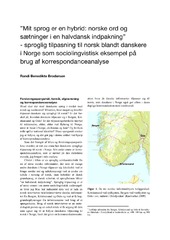”Mit sprog er en hybrid: norske ord og sætninger i en halvdansk indpakning” - sproglig tilpasning til norsk blandt danskere i Norge som sociolingvistisk eksempel på brug af korrespondanceanalyse
Peer reviewed, Journal article
Published version
Permanent lenke
https://hdl.handle.net/1956/7470Utgivelsesdato
2012Metadata
Vis full innførselSamlinger
- Department of Philosophy [235]
Sammendrag
In my presentation of my study of the linguistic accommodation to Norwegian among Danes in Norway I have shown a sociolinguistic example of the use of multible correspondence analysis. This geometric method is very suitable for sociolinguistic analyses, because it gives a visual and holistic picture. It is capable of handling all informants and variables at the same time, in one unified graphic. It shows some strong and weak forces in the accommodation among the Danes: Important factors are marital status (being married to a Dane or a Norwegian) and the number of years in Norway (< 13 years and > 21 years in Norway). My correspondence analysis shows three patterns: 1) A lexical accommodation pattern with marital status as a stronger force for a Dane married to another Dane than for a Norwegian married to a Dane, 2) residence pattern with the strongest accommodation in Kristiansand and the strongest average accommodation in Oslo, and 3) a number of years in Norway pattern where time is a force giving energy to accommodation already within a small number of years even though Danes do not accommodate more as they get older. My conclusion is that accommodation among Danes in Norway does differ in the three cities investigated. The accommodation variability is biggest in Kristiansand and most typical and average in Oslo. There are accommodation differences related to short as well as long time of residence in Norway and to being married to a another Dane or a Norwegian. Education as well is important. Age and migration age seem to be less important than one might expect. Gender and national identity do not seem to play a role in my study. However, it is important to stress that my correspondence analysis shows the complexity of the factors influencing the accommodation and the interrelation of several factors. My correspondence analysis also gives rise to new questions and theories which call upon a new correspondence analysis.
